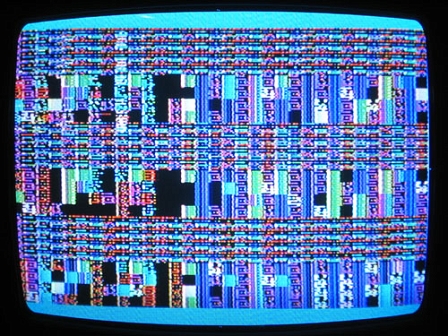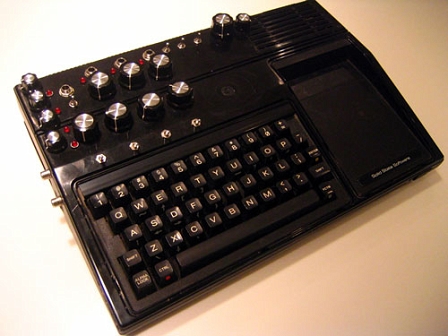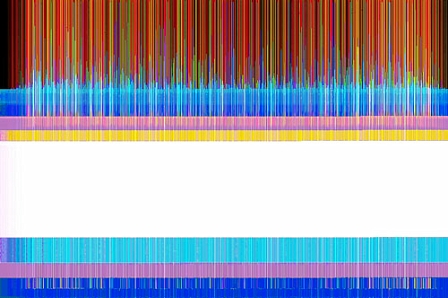Erstellt am: 2. 12. 2010 - 17:00 Uhr
Phil Stearns: Interview with a Glitchfucker
Phillip Stearns (AKA Pixel Form) is a practitioner of sonic and visual arts; music composer and performer; electronics sculptor and installation artist. He views technology as a site for exploring the global society-environment system and how changes in the relationship between society and environment manifest in our technology. Through the medium of networked systems, his work explores the horizons of information, politics, noise, control, proximity, subversion, corruption, interconnectedness and interrelatedness.
We invited him to be our artist-in-residence at Museumsquartier... and of course he will take part in Roboexotica 2010.
I did an interview with him, and -- honestly -- I think you should read it.

Phil Stearns
Some put you in the sound art drawer; but I think it's a little bit inaccurate. Not all of your work is about sound, but it all involves massive tinkering. Which drawer should we put you in?
The drawer with all the miscellaneous odds and ends that don't really have a drawer of their own. Basically every drawer in my desk is like this, but maybe that's just a problem of organization more than anything else. To get down to it, I produce some works where the goal is almost strictly to produce sound or sounds, but I can never fully ignore that sound requires the performance of an action, a body situated in space and time, vibrating and so even those works take on elements of performance art and visual art forms. I have a piece that involves two pure tones whose pitches intersect, slowly converging and then diverging over the course of 6 days. In presenting the work It wasn't simply enough to have a sound system in a room, I worked with the speakers and arranged them as an integral part of the work. The same with the lighting of that piece. Perhaps this is a slight exception to all the massive tinkering that typically goes on in my work. But the idea of tinkering with a situation is still there.
What are you currently working on?
Massive tinkering, of course! After doing a mini tour with MLB in Europe, I've been inspired to work on some new music performances and recordings that involve no-input mixer. No-input mixer is a technique made fashionable by the likes of Merzbow, Wolf Eyes, and Toshimaru Nakamura where the outputs of a mixer are connected to the inputs, creating feedback. These tones can range from piercingly high pitches to low rumbles or clicks, and mixing them together can produce intricate rhythms, tones, and soundscapes. I made a series of recordings a few years back using no-input mixer and branched out to creating complex systems of feedback using digital audio workstations and performed with no-input mixer for a bit before getting into circuit design and building my own instruments.
Other projects currently underway include sketches for performance based works involving pulleys and rope. I'll also be revisiting ideas for long-duration sound pieces that use from two to five pure tones changing very slowly over the course of several days. In addition to this, I'm building a crazy glitchy sounding noise music generator for Jesse Zbikowski's Roboexotica entry.

I did an interview with him, and -- honestly -- I think you should read it.
I called you a glitchfucker. I think because you don't like the glitch hype. Tell me about it...
I don't like that "glitch" has become mainstream. A glitch can only be unintentional; it is some momentary burst of errant electrical energy that causes an electronic device to behave spuriously, crash, or produce otherwise unanticipated and unintended output. One can say that circuit bending was the art of inducing glitches through short circuiting predominantly audio devices and later video devices. On the other side of this you have artists producing virtual glitches in software that is emulating certain pieces of hardware (i.e. Atari 2600 or Nintendo). The outcomes are very similar, but intentionally inducing a glitch in a device or by scrambling an emulation program by definition means that the result is not a glitch, it is something else altogether. It's not a lie, but it's not an honest to goodness glitch, it's already a symbolic object referring not to an accident but an intentional intervention.
Sadly, the product of the glitch is on its way to being emptied of its meaning and made a commodity; all the surface features have been exploited---copied, reproduced or intentionally induced---and are slowly being incorporated into the vocabulary of marketing. I don't mean to say that there isn't good work being done with glitches, Rosa Menkman is one of those rare artist maintaining a very positive and plural perspective on "glitch" in her work, but it is clear that the product of the glitch in general has been transformed into an icon and aesthetic. The attention has been averted from the distinction between accident, and intervention.
The next phase of the "glitch" movement (if it can be called a movement) is to go beyond the language of corruption, failure/success, and really define what is being produced, to accept that what is happening is not a glitch. Glitches happen on their own, are accidental, random, like a ray of cosmic energy smashing a fragment of DNA to bits, precipitating a mutation. If accident happens to have a negative connotation, it's only because we don't like our expectations to be subverted. The manufactured "glitches" of most "Glitch Art" are staged interventions, like a protest blocking the streets or a hacker exploiting a security flaw, or even the rigging of the US agricultural or banking systems. Some intervention precipitates an anomaly, a redirection of power, and if left unchecked, collapse.
The particulars of this process and their implications are to me more interesting than what is being done with glitches and the whole glitch aesthetic (essentially a throwback to modernism, utopia by way of dystopia). What really appeals about modifying or transforming systems to produce a glitched output is that the whole process is like giving hardware manufacturers and software companies the middle finger. The consumer good or technology has been subverted, vandalized and defaced, made amenable to individual expression. It's a truly empowering thing to get inside the system and rewrite its structures and this type of activity has the power to bring together communities sharing in a self-deterministic culture of remaking the world. This is already beyond "glitch", this is where we need to be, not in the aesthetics and symbols but in action. It is important to recognize "glitches" on societal scales, to see where others have intervened and exploited a system, then we can take a stand either for or against.

Phil Stearns
I guess you could already have killed yourself with your work, do you?
Tinkering with 120 VAC is not what I'd recommend the average DIY enthusiast to jump right into, but I'm still alive and I consider myself very lucky!
Anyone who has done some circuit bending or researched the topic will find, again and again, warnings regarding tinkering with devices that plug into the wall. I regularly ignore this, but only because I'm dumb enough to think that I know what I'm doing, well at least enough to not kill myself. When messing around with circuit bending video devices like old vintage computers and game systems (the NES is an old favorite), I found that I couldn't avoid having the things plugged in. No harm was ever done (to either myself or the devices) so I decided to learn more about power supplies, eventually learning enough to build my own. Now it's routine that I build power supplies from scratch to match the project I'm working on.
A couple of example projects include my last neural network piece. This one was actually quite dangerous because I made my own custom power strips out of a couple of terminal strips, a little more sophisticated than the kind where you screw wires down onto a board but just as sketchy. After testing that everything worked, I sealed the power distribution points in liquid rubber.
In a performance piece called "Aux Input", I play a touch controlled electronic instrument with electrodes wired to my arms. When I touch the circuit, it produces a sound using feedback completed through my body. This sound is then converted to electric shocks that cause my fingers and arms to jerk and twitch. This of course, changes the sounds and produces a sort generative of bio-feedback where the machine plays me whenever I try to play it. The whole performance is a sensory overload of sound and stroboscopic light.

Phil Stearns
If you want to meet Phil or take part in one of his workshops, please visit Roboexotica 2010. He will also be part of one of the artist talks at Roboexotica on Saturday, December 4, around 5 PM (at moe, Thelemangasse 4, 1170 Vienna).

